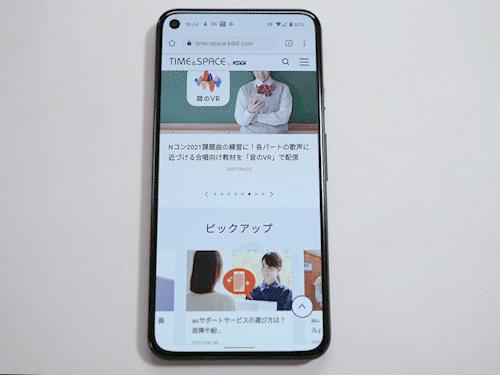"Portable Wi-Fi" Review
25/03/2022

When you operate a smartphone, have you ever thought that your finger did not reach the navigation at the bottom of the screen and it was difficult to operate?For such a case, recent smartphones have various functions, but for Android smartphones, the "gesture navigation" function is convenient.
Gesture navigation is mounted on Android10 and is used to display the home screen or return to the previous screen.In the past, it is possible to operate by tapping navigation bars such as triangular "return" keys, round "home" keys, square "application switching" by swiping on the screen.
So how do you operate?Introducing basic usage and precautions for gesture navigation.
In gesture navigation, the navigation bar at the bottom of the screen is gone, and only a thin bar is displayed.The appearance and the operation method greatly change, but what you can do is basically the same as before.
Swipe up from the bottom of the screen.
Swipe toward the center from either left or right end.

Swipe up from the bottom of the screen, stop your finger as it is, press and hold to release.
The placement and icon shape may differ depending on the model, but in the Android standard GooglePixel terminal, [◀] on the left side is ② (return to the previous screen), and [◎] in the middle is ① (return to the home screen)., The [■] on the right is equivalent to ③ (switching the app).
Android9.In 0 and 10, "2 button navigation" can be used separately, in that case, on the left [
In the first place, the navigation bar is gone, and the advantage of gesture navigation is that the screen can be used widely.
Also, in the conventional navigation, it is necessary to tap the bottom of the screen, so it may be difficult to operate with one hand when using a large screen smartphone.However, in the case of gesture navigation, it does not need to be reached to the center of the screen even when displaying the home screen, so you can swipe up from the bottom of the screen, so you do not choose the location of the operation.In the case of the return operation, you only need to swipe from the left and right to the center, and you can also operate it naturally with one hand.
In addition, there is an operation that can only be used with gesture navigation that cannot be done with a conventional navigation bar.That is the operation of swiping the bar at the bottom of the screen left and right.As a result, the running application can be switched quickly.
Gesture navigation is available only for Android 10 or later.The following is the case of GooglePixel5, which is also a standard setting of Android, but in the case of Galaxy, the setting item is not a "system" but on the "display", and some models and manufacturers differ greatly depending on the model and manufacturer.If you can't find any settings, you'll find it by searching for "navigation" on the setting screen.
① Tap [System] ▶ [Gesture] from "Settings".
② Select Gesture Navigation from [System Navigation].
If you want to return to the navigation of the conventional three or two buttons after setting the gesture navigation, you can easily restore it from this screen.
It is a gesture navigation that is convenient to get used to, but be careful not to use it unless it is Android10 or later.In addition, although swipe operation from the edge of the screen is accompanied by a smartphone with a curved screen edge, the finger may be returned and returned.
In such a case, please adjust the operation sensitivity by setting the gesture navigation.If you lower the sensitivity, the malfunction should be reduced.Conversely, if the operation is not recognized well, set the sensitivity to a higher sensitivity.
There are three buttons, or gestures, and there are problems with preference.If you haven't tried it yet, please try it.
Sentence: Tatsuya Yamamoto